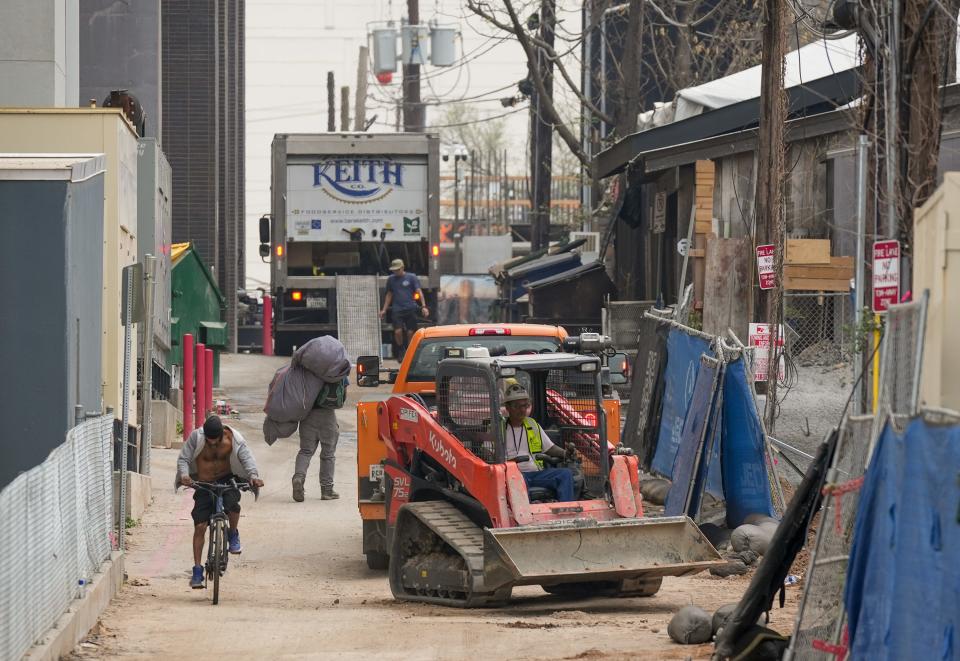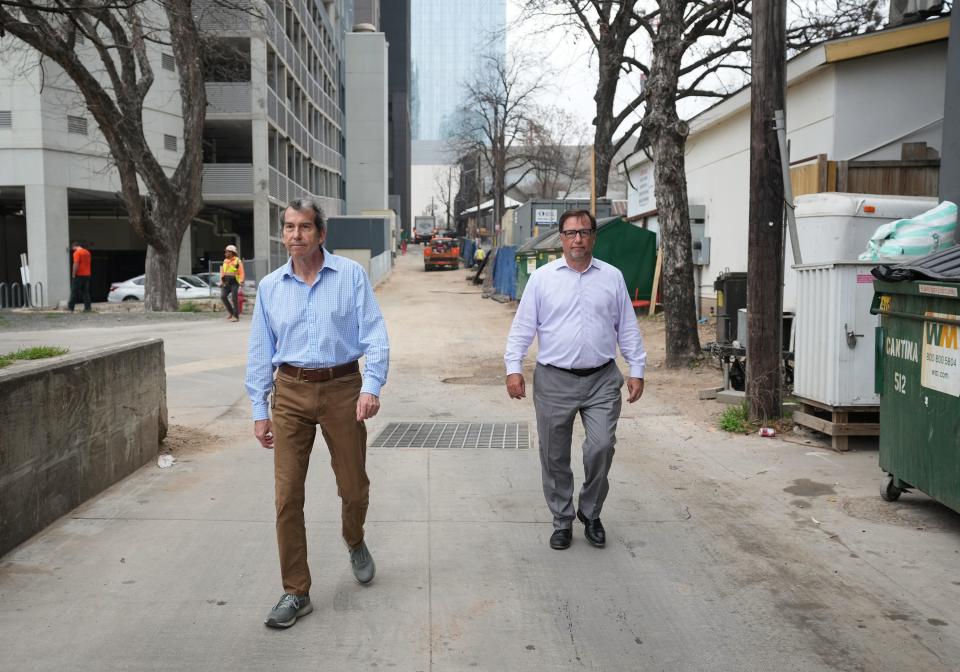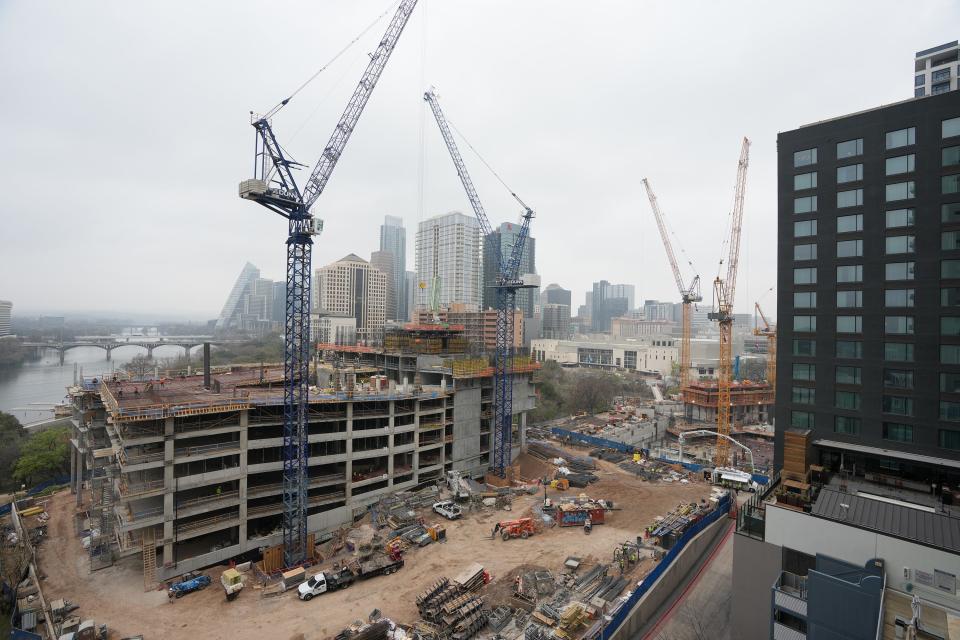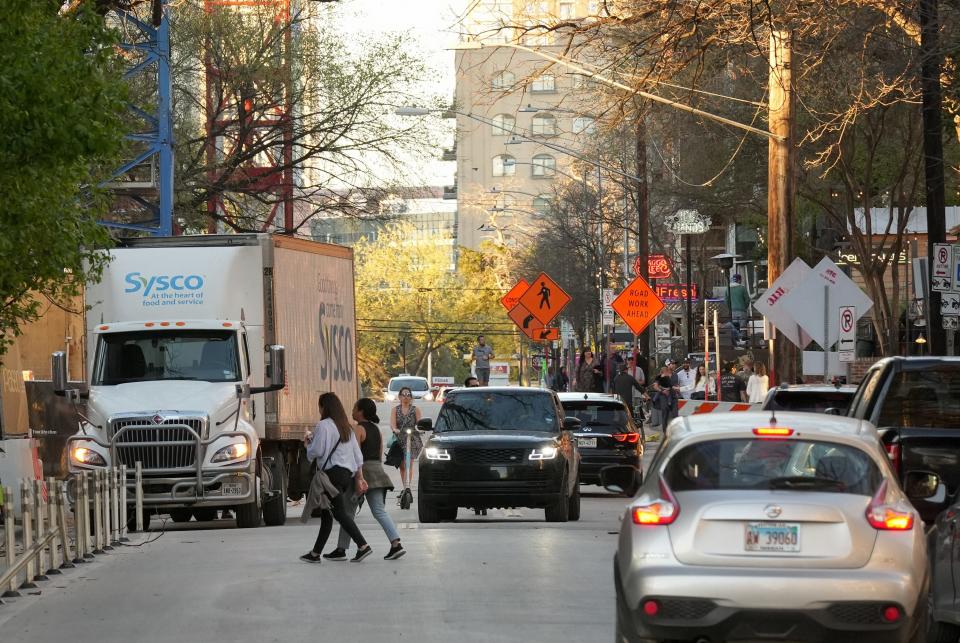Grumet: Traffic in Rainey district is already 'very challenging.' It's about to get worse.
A quick walk around the Rainey Street District, and you can see why Tom Haider is worried.
Construction barricades jut into the street on several blocks, temporarily shaving off a car lane here or there, as crews build the skyscrapers that will pack thousands more residents into this tiny pocket of Austin.
On-street parking and untended dumpsters have squeezed a few passageways down to a single lane, used by cars going in both directions. Delivery trucks and Uber drivers stop pretty much anywhere they please, even if it brings an entire street to a standstill for several minutes.
And then, sometime after March 21, after the South by Southwest crowds have cleared out, a key access point to the Rainey district will be fully closed for at least a month, followed by partial lane closures for 14 to 16 weeks. The temporary closure of Red River Street, between César Chávez and Driskill streets, will allow crews to lay chilled water lines for the Waterline, a 74-story tower that will be one of the tallest buildings in Texas.

“How are we going to get emergency vehicles in here?” asked Haider, a retiree who lives in the Shore Condominiums. “That’s my biggest concern.”
City transportation officials say first responders will still have clearance access through three side streets: Driskill, River and Cummings streets, the first two connecting to the Interstate 35 frontage road.
But again: It doesn’t take much to bring traffic to a halt in the Rainey district. The temporary closure of Red River Street just south of César Chávez will exacerbate that over the next few months.
And those delays will be just a teaser for the gridlock to come unless city planners put together a holistic traffic and mobility plan to support the jaw-dropping amount of growth happening in the Rainey district.
Bob Nicks, an Austin Fire Department battalion chief, told me the sheer volume of construction in the Rainey district makes access “very, very challenging.” But he said Fire Department inspectors visit the area a couple of times a day to ensure the roads along the construction sites remain passable for emergency crews.
“It is challenging. It’s certainly far from ideal,” he said. But they’re making it work.
The bigger worry for him — and for many residents in this highly coveted waterfront enclave — is how people will get around once those construction sites become skyscrapers filled with thousands of new residents. Consider the staggering number of housing units at the towers being built right now:

352 apartments at the Waterline, the tower that will command the Austin skyline from its perch at Red River and César Chávez.
423 apartments at The Travis, in the first of two towers planned just south of the Waterline.
345 condominiums at Modern Austin Residences, a 56-story high-rise on Davis Street.
557 apartments at Paseo, a skyscraper sprouting along Rainey Street.
377 upscale apartments at 700 River, a 43-story tower rising where River meets Rainey.
284 condominiums at Vesper, a 41-story high-rise overlooking East Avenue.
All of these towers are getting packed into a Rainey district that’s just one-tenth of a square mile, hemmed in to the south by Lady Bird Lake and to the west by Waller Creek. The streets were built decades ago, when this was a close-knit, Mexican American neighborhood of single-family homes. Now, it’s filling with high-rises that will make it the most densely populated section of the city.
Notably, the Waterline developer will make some traffic improvements, including adding a northbound lane to Red River Street as it approaches César Chávez and realigning that crooked intersection so it functions more effectively.

Meanwhile, the original plans for Project Connect included a Blue Line of light rail with a stop near the Rainey district, which would provide a much-needed link to mass transit. But who knows if or when that transit stop will arrive, given the ballooning costs facing Project Connect. A leaked batch of revised route options, obtained last week by Austin Politics Newsletter's Jack Craver, shows the Austin Transit Partnership is exploring different ideas for a pared-down first phase of light rail. None of those options would stop at Rainey, although expanded bus service could.
In the long run, Nicks suggested the city look at making some streets in the Rainey district one-way, which would make it easier for cars to move aside for emergency vehicles. He also suggested establishing designated pickup and drop-off spots for Uber drivers so they don’t block traffic. (Such a setup would need to be enforced with hefty fines to be effective.)
Residents offered other ideas at a town hall meeting Monday evening at Banger's Sausage House & Beer Garden, where a standing-room-only crowd filled the basement. Among the ideas: Remove the on-street parking. Invest in bike/pedestrian amenities to help people safely travel without cars. Extend Rainey Street north so it intersects with César Chávez (an idea city planners said they’re exploring, once the owners of property there seek to redevelop it).
Yet even those solutions are dwarfed by the scale of transportation challenges headed this way, most notably the Texas Department of Transportation's planned overhaul of I-35, which would entail years of construction and detours for a revamped interstate with fewer access points downtown.
“We’ve got a lot of work to do,” Richard Mendoza, Austin Transportation Department interim director, told the crowd at the Rainey district town hall meeting, drawing chuckles for such an understatement.
And the clock is ticking.
Grumet is the Statesman’s Metro columnist. Her column, ATX in Context, contains her opinions. Share yours via email at bgrumet@statesman.com or via Twitter at @bgrumet. Find her previous work at statesman.com/news/columns.

This article originally appeared on Austin American-Statesman: Rainey district traffic is 'very challenging.' It's about to get worse

